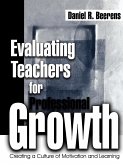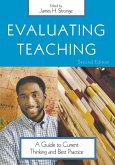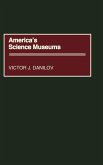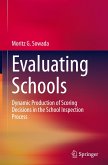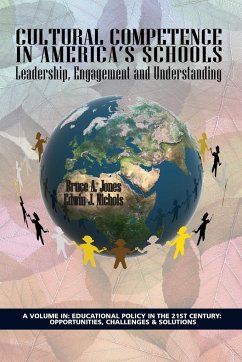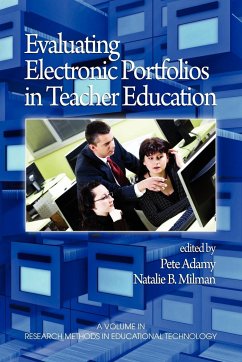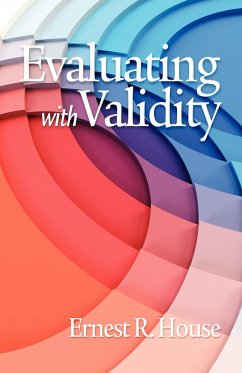- Broschiertes Buch
- Merkliste
- Auf die Merkliste
- Bewerten Bewerten
- Teilen
- Produkt teilen
- Produkterinnerung
- Produkterinnerung
When teacher evaluations are fair, everyone wins. Poor evaluation systems don't just hurt teachers-they hurt students, too. That's why America can't afford to wait for the teacher-evaluation problem to be solved. To provide balanced, accurate, and rigorous evaluations that take into account each teacher's particular circumstances, only one system can work: evidence-governed collegial judgment. This book includes: A discussion of common evaluation systems, including testing, value-added models, and observations Analysis of federal guidelines and state responses Action steps teachers and school…mehr
Andere Kunden interessierten sich auch für
![Evaluating Teachers for Professional Growth Evaluating Teachers for Professional Growth]() Daniel R. BeerensEvaluating Teachers for Professional Growth42,99 €
Daniel R. BeerensEvaluating Teachers for Professional Growth42,99 €![Evaluating Teaching Evaluating Teaching]() James H. StrongeEvaluating Teaching45,99 €
James H. StrongeEvaluating Teaching45,99 €![America's Science Museums America's Science Museums]() Victor J. DanilovAmerica's Science Museums92,99 €
Victor J. DanilovAmerica's Science Museums92,99 €![Evaluating Schools Evaluating Schools]() Moritz G. SowadaEvaluating Schools105,99 €
Moritz G. SowadaEvaluating Schools105,99 €![Cultural Competence in America's Schools Cultural Competence in America's Schools]() Bruce A. JonesCultural Competence in America's Schools63,99 €
Bruce A. JonesCultural Competence in America's Schools63,99 €![Evaluating Electronic Portfolios in Teacher Education (PB) Evaluating Electronic Portfolios in Teacher Education (PB)]() Evaluating Electronic Portfolios in Teacher Education (PB)63,99 €
Evaluating Electronic Portfolios in Teacher Education (PB)63,99 €![Evaluating with Validity (PB) Evaluating with Validity (PB)]() Ernest R. HouseEvaluating with Validity (PB)48,99 €
Ernest R. HouseEvaluating with Validity (PB)48,99 €-
-
When teacher evaluations are fair, everyone wins. Poor evaluation systems don't just hurt teachers-they hurt students, too. That's why America can't afford to wait for the teacher-evaluation problem to be solved. To provide balanced, accurate, and rigorous evaluations that take into account each teacher's particular circumstances, only one system can work: evidence-governed collegial judgment. This book includes: A discussion of common evaluation systems, including testing, value-added models, and observations Analysis of federal guidelines and state responses Action steps teachers and school leaders can take to influence policy A clear rationale and strategies for implementing a teacher evaluation model based on human judgment
Hinweis: Dieser Artikel kann nur an eine deutsche Lieferadresse ausgeliefert werden.
Hinweis: Dieser Artikel kann nur an eine deutsche Lieferadresse ausgeliefert werden.
Produktdetails
- Produktdetails
- Verlag: Corwin
- Seitenzahl: 200
- Erscheinungstermin: 17. April 2013
- Englisch
- Abmessung: 229mm x 152mm x 11mm
- Gewicht: 298g
- ISBN-13: 9781452260853
- ISBN-10: 1452260850
- Artikelnr.: 36268491
- Herstellerkennzeichnung
- Libri GmbH
- Europaallee 1
- 36244 Bad Hersfeld
- gpsr@libri.de
- Verlag: Corwin
- Seitenzahl: 200
- Erscheinungstermin: 17. April 2013
- Englisch
- Abmessung: 229mm x 152mm x 11mm
- Gewicht: 298g
- ISBN-13: 9781452260853
- ISBN-10: 1452260850
- Artikelnr.: 36268491
- Herstellerkennzeichnung
- Libri GmbH
- Europaallee 1
- 36244 Bad Hersfeld
- gpsr@libri.de
W. James Popham, professor emeritus at University of California Graduate School of Education and Information Studies, has spent the bulk of his educational career as a teacher. His first teaching assignment, for example, was in a small eastern Oregon high school where he taught English and social studies while serving as yearbook advisor, class sponsor, and unpaid tennis coach. That recompense meshed ideally with the quality of his coaching. Most of Dr. Popham¿s teaching career took place at UCLA where, for nearly 30 years, he taught courses in instructional methods for prospective teachers as well as courses in evaluation and measurement for graduate students. At UCLA he won several distinguished teaching awards. In January 2000, he was recognized by UCLA Today as one of UCLA's top 20 professors of the 20th century. (He notes that the 20th century was a full-length century, unlike the current abbreviated one.) In 1992, he took early retirement from UCLA upon learning that emeritus professors received free parking. Because at UCLA he was acutely aware of the perishability of professors who failed to publish, he spent his non-teaching hours affixing words to paper. The result: 30 books, 200 journal articles, 50 research reports, and 175 papers presented before research societies. Although not noted in his official vita, while at UCLA he also authored 1,426 grocery lists. His most recent books are Classroom Assessment: What Teachers Need to Know, 6th Ed. (2010) and Assessment for Educational Leaders (2006), Allyn & Bacon; The Truth About Testing (2001), Test Better, Teach Better (2003), Transformative Assessment (2008) and Instruction that Measures Up (2009) ASCD; America's "Failing" Schools (2005) and Mastering Assessment (2006), Routledge; and Unlearned Lessons (2009) Harvard Education Press. He encourages purchase of these books because he regards their semi-annual royalties as psychologically reassuring. In 1978, Dr. Popham was elected to the presidency of the American Educational Research Association (AERA). He was also the founding editor of Educational Evaluation and Policy Analysis, a quarterly journal published by AERA. A Fellow of the Association, he has attended each year¿s AERA meeting since his first in 1958. He is inordinately compulsive. In 1968, Dr. Popham established IOX Assessment Associates, an R&D group that formerly created statewide student achievement tests for a dozen states. He has personally passed all of those tests, largely because of his unlimited access to the tests' answer keys. In 2002 the National Council on Measurement in Education presented him with its Award for Career Contributions to Educational Measurement. In 2006 he was awarded a Certificate of Recognition by the National Association of Test Directors. In 2009, he was appointed to be a board member of the National Assessment Governing Board. Dr. Popham's complete 44-page, single-spaced vita can be requested. It is really dull reading. School Leadership Briefing Interview
Preface Acknowledgments 1. What Underlies the Tightening of Today
s Teacher-Evaluation Programs? What Uncle Sam Wants A Federal Vision of Teacher Evaluation What Could Go Wrong? Chapter Implications for Three Audiences 2. Human Judgment: Needed or Not? Human Judgment
s Role Evaluation Basics What about the Evaluation of Teachers? Judgment-Requisite Choices Chapter Implications for Three Audiences 3. Defensible Teacher Evaluation The Wonders of Whereas Why Use a Weighted-Evidence Judgmental Approach to Teacher Evaluation? A Weighted-Evidence Judgment Evaluative Survey Who Are the Judges? Chapter Implications for Three Audiences 4. Evidence from Standardized Tests Key Testing Tenets Why We Test A Psychometric Blessed Trinity Standardized Test- Two Tribes, Two Tasks Traditional Test-Building and Its Off-Task Allure The Origins of Traditional Educational Testing Dealing with Effective Instruction Ensuring Score-Spread from the Get-Go Instructional Sensitivity as a Requisite Returning to Validity Evidential-Weight Guidelines Chapter Implications for Three Audiences 5. Evidence from Classroom Assessments Staking Out the Nature of "Classroom Assessment" A Quest for Evidence of Student Growth Formative and Summative Applications Enhancing the Quality of Classroom-Assessment Evidence Evidence of a Teacher
s Instructional Ability What
s Assessed The Traditional Psychometric Triplets Following Test Development, Improvement, and Scoring Rules Have Teachers Played it Straight? Evidential-Weight Guidelines Chapter Implications for Three Audiences 6. Evidence from Classroom Observations What
s Distinctive about Classroom Observations? Observations Versus Ratings Playing the Odds: Observation of Instructional Means An Observational Reality: The Mysterious Middle Group Getting the Most Evaluative Mileage Out of Classroom Observation Evidence Two Widely-Used Observation Procedures Danielson
s Framework for Teaching The Marzano Model Evidential-Weight Guidelines Chapter Implications for Three Audiences 7. Evidence from Ratings Rooting Around with Ratings Lurking Comparisons Amalgam Judgments Three Flavors of Bias Administrators
Ratings Students
Ratings Making Ratings Righteous The Rating Form Rater Preparation The Old and the New Evidential-Weight Guidelines Chapter Implications for Three Audiences 8. Evidence from Sundry Sources Alternative Sources of Evidence for Evaluating Teachers Academic Achievements Changes in Students
Affect Lesson Plans Opportunity-to-Learn Student Surveys Parental Engagement Parent Ratings Professional Development Ratings by Colleagues Student Interviews Teacher-Made Tests Teachers
Self-Ratings Augmentation or Obfuscation? Evidential-Weight Guidelines Chapter Implications for Three Audiences 9. Mission Possible? Weighted-Evidence Judgment of Teachers: A Reprise What To Do- And How? Chapter Imlpications for Three Audiences Responding to a Subtitle Index
s Teacher-Evaluation Programs? What Uncle Sam Wants A Federal Vision of Teacher Evaluation What Could Go Wrong? Chapter Implications for Three Audiences 2. Human Judgment: Needed or Not? Human Judgment
s Role Evaluation Basics What about the Evaluation of Teachers? Judgment-Requisite Choices Chapter Implications for Three Audiences 3. Defensible Teacher Evaluation The Wonders of Whereas Why Use a Weighted-Evidence Judgmental Approach to Teacher Evaluation? A Weighted-Evidence Judgment Evaluative Survey Who Are the Judges? Chapter Implications for Three Audiences 4. Evidence from Standardized Tests Key Testing Tenets Why We Test A Psychometric Blessed Trinity Standardized Test- Two Tribes, Two Tasks Traditional Test-Building and Its Off-Task Allure The Origins of Traditional Educational Testing Dealing with Effective Instruction Ensuring Score-Spread from the Get-Go Instructional Sensitivity as a Requisite Returning to Validity Evidential-Weight Guidelines Chapter Implications for Three Audiences 5. Evidence from Classroom Assessments Staking Out the Nature of "Classroom Assessment" A Quest for Evidence of Student Growth Formative and Summative Applications Enhancing the Quality of Classroom-Assessment Evidence Evidence of a Teacher
s Instructional Ability What
s Assessed The Traditional Psychometric Triplets Following Test Development, Improvement, and Scoring Rules Have Teachers Played it Straight? Evidential-Weight Guidelines Chapter Implications for Three Audiences 6. Evidence from Classroom Observations What
s Distinctive about Classroom Observations? Observations Versus Ratings Playing the Odds: Observation of Instructional Means An Observational Reality: The Mysterious Middle Group Getting the Most Evaluative Mileage Out of Classroom Observation Evidence Two Widely-Used Observation Procedures Danielson
s Framework for Teaching The Marzano Model Evidential-Weight Guidelines Chapter Implications for Three Audiences 7. Evidence from Ratings Rooting Around with Ratings Lurking Comparisons Amalgam Judgments Three Flavors of Bias Administrators
Ratings Students
Ratings Making Ratings Righteous The Rating Form Rater Preparation The Old and the New Evidential-Weight Guidelines Chapter Implications for Three Audiences 8. Evidence from Sundry Sources Alternative Sources of Evidence for Evaluating Teachers Academic Achievements Changes in Students
Affect Lesson Plans Opportunity-to-Learn Student Surveys Parental Engagement Parent Ratings Professional Development Ratings by Colleagues Student Interviews Teacher-Made Tests Teachers
Self-Ratings Augmentation or Obfuscation? Evidential-Weight Guidelines Chapter Implications for Three Audiences 9. Mission Possible? Weighted-Evidence Judgment of Teachers: A Reprise What To Do- And How? Chapter Imlpications for Three Audiences Responding to a Subtitle Index
Preface Acknowledgments 1. What Underlies the Tightening of Today
s Teacher-Evaluation Programs? What Uncle Sam Wants A Federal Vision of Teacher Evaluation What Could Go Wrong? Chapter Implications for Three Audiences 2. Human Judgment: Needed or Not? Human Judgment
s Role Evaluation Basics What about the Evaluation of Teachers? Judgment-Requisite Choices Chapter Implications for Three Audiences 3. Defensible Teacher Evaluation The Wonders of Whereas Why Use a Weighted-Evidence Judgmental Approach to Teacher Evaluation? A Weighted-Evidence Judgment Evaluative Survey Who Are the Judges? Chapter Implications for Three Audiences 4. Evidence from Standardized Tests Key Testing Tenets Why We Test A Psychometric Blessed Trinity Standardized Test- Two Tribes, Two Tasks Traditional Test-Building and Its Off-Task Allure The Origins of Traditional Educational Testing Dealing with Effective Instruction Ensuring Score-Spread from the Get-Go Instructional Sensitivity as a Requisite Returning to Validity Evidential-Weight Guidelines Chapter Implications for Three Audiences 5. Evidence from Classroom Assessments Staking Out the Nature of "Classroom Assessment" A Quest for Evidence of Student Growth Formative and Summative Applications Enhancing the Quality of Classroom-Assessment Evidence Evidence of a Teacher
s Instructional Ability What
s Assessed The Traditional Psychometric Triplets Following Test Development, Improvement, and Scoring Rules Have Teachers Played it Straight? Evidential-Weight Guidelines Chapter Implications for Three Audiences 6. Evidence from Classroom Observations What
s Distinctive about Classroom Observations? Observations Versus Ratings Playing the Odds: Observation of Instructional Means An Observational Reality: The Mysterious Middle Group Getting the Most Evaluative Mileage Out of Classroom Observation Evidence Two Widely-Used Observation Procedures Danielson
s Framework for Teaching The Marzano Model Evidential-Weight Guidelines Chapter Implications for Three Audiences 7. Evidence from Ratings Rooting Around with Ratings Lurking Comparisons Amalgam Judgments Three Flavors of Bias Administrators
Ratings Students
Ratings Making Ratings Righteous The Rating Form Rater Preparation The Old and the New Evidential-Weight Guidelines Chapter Implications for Three Audiences 8. Evidence from Sundry Sources Alternative Sources of Evidence for Evaluating Teachers Academic Achievements Changes in Students
Affect Lesson Plans Opportunity-to-Learn Student Surveys Parental Engagement Parent Ratings Professional Development Ratings by Colleagues Student Interviews Teacher-Made Tests Teachers
Self-Ratings Augmentation or Obfuscation? Evidential-Weight Guidelines Chapter Implications for Three Audiences 9. Mission Possible? Weighted-Evidence Judgment of Teachers: A Reprise What To Do- And How? Chapter Imlpications for Three Audiences Responding to a Subtitle Index
s Teacher-Evaluation Programs? What Uncle Sam Wants A Federal Vision of Teacher Evaluation What Could Go Wrong? Chapter Implications for Three Audiences 2. Human Judgment: Needed or Not? Human Judgment
s Role Evaluation Basics What about the Evaluation of Teachers? Judgment-Requisite Choices Chapter Implications for Three Audiences 3. Defensible Teacher Evaluation The Wonders of Whereas Why Use a Weighted-Evidence Judgmental Approach to Teacher Evaluation? A Weighted-Evidence Judgment Evaluative Survey Who Are the Judges? Chapter Implications for Three Audiences 4. Evidence from Standardized Tests Key Testing Tenets Why We Test A Psychometric Blessed Trinity Standardized Test- Two Tribes, Two Tasks Traditional Test-Building and Its Off-Task Allure The Origins of Traditional Educational Testing Dealing with Effective Instruction Ensuring Score-Spread from the Get-Go Instructional Sensitivity as a Requisite Returning to Validity Evidential-Weight Guidelines Chapter Implications for Three Audiences 5. Evidence from Classroom Assessments Staking Out the Nature of "Classroom Assessment" A Quest for Evidence of Student Growth Formative and Summative Applications Enhancing the Quality of Classroom-Assessment Evidence Evidence of a Teacher
s Instructional Ability What
s Assessed The Traditional Psychometric Triplets Following Test Development, Improvement, and Scoring Rules Have Teachers Played it Straight? Evidential-Weight Guidelines Chapter Implications for Three Audiences 6. Evidence from Classroom Observations What
s Distinctive about Classroom Observations? Observations Versus Ratings Playing the Odds: Observation of Instructional Means An Observational Reality: The Mysterious Middle Group Getting the Most Evaluative Mileage Out of Classroom Observation Evidence Two Widely-Used Observation Procedures Danielson
s Framework for Teaching The Marzano Model Evidential-Weight Guidelines Chapter Implications for Three Audiences 7. Evidence from Ratings Rooting Around with Ratings Lurking Comparisons Amalgam Judgments Three Flavors of Bias Administrators
Ratings Students
Ratings Making Ratings Righteous The Rating Form Rater Preparation The Old and the New Evidential-Weight Guidelines Chapter Implications for Three Audiences 8. Evidence from Sundry Sources Alternative Sources of Evidence for Evaluating Teachers Academic Achievements Changes in Students
Affect Lesson Plans Opportunity-to-Learn Student Surveys Parental Engagement Parent Ratings Professional Development Ratings by Colleagues Student Interviews Teacher-Made Tests Teachers
Self-Ratings Augmentation or Obfuscation? Evidential-Weight Guidelines Chapter Implications for Three Audiences 9. Mission Possible? Weighted-Evidence Judgment of Teachers: A Reprise What To Do- And How? Chapter Imlpications for Three Audiences Responding to a Subtitle Index


